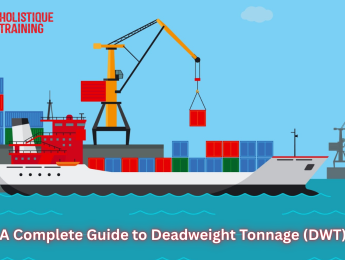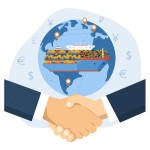- Table of Contents
- Introduction
- What Is Deadweight Tonnage (DWT)?
- How Is Deadweight Tonnage Measured?
- 1. Draft Readings
- 2. Use of Hydrostatic Tables and Curves
- 3. Subtracting the Lightweight
- 4. Consideration of Water Type and Density
- 5. Draft Survey Method (for Cargo Calculation)
- The Importance of Deadweight Tonnage in Maritime
- 1. Commercial Value and Profitability
- 2. Operational Planning and Voyage Efficiency
- 3. Fuel Consumption and Environmental Impact
- 4. Port Access and Navigational Safety
- 5. Safety and Stability at Sea
- 6. Legal and Insurance Compliance
- Comparing DWT with Other Tonnage Measurements
- Deadweight Tonnage and International Shipping Compliance
- 1. Load Line Regulations (Plimsoll Line)
- 2. SOLAS and MARPOL
- 3. Classification Societies
- 4. Charter Parties and Contracts
- How to Use Deadweight Tonnage in Maritime Operations
- 1. Voyage Planning and Route Optimization
- 2. Cargo Load Optimization
- 3. Fleet Management and Vessel Assignment
- 4. Ship Design and Retrofitting Projects
- 5. Environmental Performance and Carbon Intensity
- 6. Contingency Planning and Risk Mitigation
- Conclusion
Introduction
Modern maritime shipping is a vast and highly technical industry, one that is both deeply traditional and constantly evolving. Beneath the surface of container ships, oil tankers, and cargo carriers lies a complex world of engineering, navigation, regulation, and measurement. Among the many terms used to evaluate a ship’s performance and capacity,deadweight tonnage—commonly abbreviated asDWT—holds a central place.
This blog post explores the concept ofdeadweight tonnage, what it means, how it’s measured, why it matters, and how it compares to other types of tonnage like gross tonnage, net tonnage, and DWCC (Deadweight Cargo Capacity). It also discusses its significance in compliance with international maritime regulations and how DWT impacts operational decision-making in global shipping.
What Is Deadweight Tonnage (DWT)?
Deadweight tonnage (DWT) refers to themaximum weight a ship can safely carry, including cargo, fuel, fresh water, ballast water, provisions, passengers, and crew,excluding the weight of the ship itself. In essence, DWT measures the total “burden” the ship can handle when fully loaded and seaworthy.
This measurement is expressed inmetric tons (1,000 kilograms per ton) orlong tons (2,240 pounds per ton), depending on regional preferences and regulatory contexts. DWT is not to be confused with the physical weight of the ship’s structure—that is known as thelightweight of the ship.
Mathematically, DWT can be represented as:
DWT = Displacement at Full Load – Lightweight
- Displacement at Full Load is the total weight of the ship when fully loaded and sitting at its maximum permitted draft.
- Lightweight refers to the weight of the vessel itself, including the hull, machinery, equipment, and other permanent parts of the ship.
By subtracting the lightweight from the full displacement, shipowners and maritime professionals determine how much additional weight the vessel can legally and safely carry.
How Is Deadweight Tonnage Measured?
Measuring deadweight tonnage (DWT) is not a matter of simply weighing the vessel like a truck on a scale. Instead, it involves a combination of hydrodynamic principles, precise observations, and reference to vessel-specific documentation. The process is highly technical and rooted in the physics of buoyancy—where a floating body displaces a volume of water equal to its own weight.
Here’s how the process unfolds in practice:
1. Draft Readings
Every ship hasdraft marks etched on both sides of its hull—located at the bow (forward), stern (aft), and midship. These marks indicate how deeply the ship is submerged in water. When a ship is being loaded, its draft increases as it becomes heavier and displaces more water.
To measure DWT, marine surveyors first take readings of the vessel’s draft at multiple points, usually:
- Forward (F)
- Aft (A)
- Midship (M)
These readings help calculate themean draft, which is the average depth of the vessel below the waterline. This value serves as the foundation for determining how much water the vessel is displacing—i.e., how much it weighs in its current state.
2. Use of Hydrostatic Tables and Curves
Each ship has a unique set ofhydrostatic tables andcurves—technical documents produced by naval architects during the design and construction phases. These tables provide data correlating specific draft levels with displacement values.
For example, if the mean draft of a vessel is measured to be 12.3 meters, the hydrostatic tables will tell you how many metric tons of water the ship displaces at that draft—perhaps 75,000 metric tons.
This displacement figure includes everything on board: the weight of the ship’s structure, cargo, fuel, fresh water, provisions, crew, and ballast. It is the total mass of the ship and everything it contains while floating at the measured draft.
3. Subtracting the Lightweight
To isolate thedeadweight tonnage, we must subtract the ship’slightweight—which is the weight of the ship itself, empty of cargo, fuel, and consumables. This figure is fixed and documented during the vessel’s construction and delivery.
Formula Recap:
DWT = Displacement at Full Load – Lightweight
For instance, if the displacement at full load is 75,000 metric tons and the lightweight is 20,000 metric tons, the DWT is:
75,000 – 20,000 = 55,000 metric tons
This means the ship can safely carry 55,000 metric tons of cargo, fuel, crew, water, and provisions.
4. Consideration of Water Type and Density
It’s essential to note that water density affects draft and displacement. Ships floathigher in saltwater than they do in freshwater because saltwater is denser. As a result, a ship’s DWT can vary depending on whether it's operating in marine or inland environments. For precise measurement, surveyors adjust calculations based on thewater’s specific gravity (e.g., 1.025 for saltwater and 1.000 for freshwater).
Draft readings and hydrostatic tables are therefore appliedin conjunction with corrections for water density, temperature, and trim (the difference in draft between the forward and aft of the ship).
5. Draft Survey Method (for Cargo Calculation)
In many shipping operations—especially bulk carriers and tankers—adraft survey is used to calculate the weight of cargo loaded or discharged. This involves comparing draft readings and displacement before and after loading or unloading, then subtracting any changes in consumables (fuel, water, etc.) to arrive at the weight of cargo.
Draft surveys are often conducted at both the load port and discharge port, serving as official documentation of cargo volume for payment and legal verification.
This comprehensive process ensures that ships remain within safe load limits, maximize cargo capacity, and comply with port and regulatory requirements. Precision in DWT measurement isn't just a technical formality—it’s essential for safety, efficiency, and economic performance in maritime logistics.
The Importance of Deadweight Tonnage in Maritime
Deadweight tonnage (DWT) is far more than a technical figure buried in a vessel’s documentation. It is astrategic cornerstone of global maritime logistics, directly influencing the safety, profitability, efficiency, and legal compliance ofshipping operations. Whether it's a massive oil tanker crossing oceans or a regional container ship navigating a coastal route, DWT determines how much can be carried, how much can be earned, and how a ship is managed on every voyage.
1. Commercial Value and Profitability
At its core, shipping is a business—and in this business,space and weight equal revenue. The DWT figure sets the upper limit for thepayload capacity of a vessel. The more a ship can carry, the more it can earn on each voyage. This is especially true for vessels transportingbulk commodities like crude oil, coal, iron ore, grain, and LNG, where freight rates are often quoted in dollars per ton of cargo.
Shipowners and charterers closely analyze DWT when assessing:
- Freight rate negotiations (e.g., per ton, per day, per voyage)
- Return on investment (ROI) for new builds or secondhand purchases
- Cost-benefit scenarios when determining voyage feasibility or route selection
A vessel with higher DWT typically offersgreater earning potential, assuming all other factors—like port access and fuel consumption—are optimized.
2. Operational Planning and Voyage Efficiency
Every ship has operational constraints—fuel availability, port draft restrictions, weather forecasts, and delivery timelines. DWT serves as aplanning tool that informs how the vessel should be loaded and operated on any given route.
For example, a ship may be technically capable of carrying 65,000 metric tons, but if it must pass through a shallow port or canal with strict draft limits, the vessel may only load 50,000 metric tons to remain compliant. Planners must balance:
- Cargo volume vs. permissible draft
- Fuel weight vs. voyage duration
- Ballast requirements for trim and balance
DWT provides the numerical framework within which these trade-offs are managed efficiently and safely.
3. Fuel Consumption and Environmental Impact
There’s a direct relationship between a ship’s load and itsfuel consumption. As the DWT utilization increases, so does the energy required to move the ship through water. This affects not only cost efficiency but alsocarbon emissions, which are under increasing scrutiny by global regulators.
For example, international measures like theIMO’s Carbon Intensity Indicator (CII) andEnergy Efficiency Existing Ship Index (EEXI) use DWT to benchmark emissions per ton-mile of transported goods. Operators who optimize their DWT utilization—ensuring ships are neither underloaded (wasting capacity) nor overloaded (wasting fuel)—gain a competitive edge in fuel savings and regulatory compliance.
Additionally, precise control of DWT helps avoidexcessive fuel use, which reduces the vessel’scarbon footprint and contributes toenvironmental sustainability—a rising priority in maritime transport.

4. Port Access and Navigational Safety
Many ports, inland waterways, and canals imposemaximum draft limits that indirectly restrict the DWT a vessel can carry. A ship that exceeds draft limits may be denied entry, forced to wait for favorable tide conditions, or required tooffload part of its cargo onto a lighter vessel—all of which result in costly delays and logistical complications.
Knowing the ship’s DWT and how it interacts withregional maritime infrastructure allows shipping companies to:
- Select the right vessel for the route
- Avoid penalties or denied port access
- Schedule cargo more precisely
- Ensure compliance with local maritime authorities
In constrained or congested ports, efficient DWT usage translates directly intofaster turnaround times and lower port fees.
5. Safety and Stability at Sea
One of the most critical aspects of DWT is its role inmaritime safety. Overloading a ship can severely affect itsstability, buoyancy, and freeboard—the distance between the waterline and the deck. This increases the risk of water ingress in rough seas, higher stress on the hull structure, and poor maneuverability, especially during adverse weather.
A ship operating beyond its designated DWT:
- May become unstable during heavy swells
- Faces difficulty in maintaining speed and course
- Is at greater risk of capsizing or structural failure
By adhering strictly to the DWT limit, shipmasters ensure that vessels maintain an optimal balance of weight, trim, and structural integrity—vital forcrew safety and cargo protection.
6. Legal and Insurance Compliance
From insurance underwriters to port authorities, many stakeholders in the maritime ecosystem rely on DWT as areference metric. Insurance premiums, for instance, are partly based on the declared DWT of the vessel. Overloading beyond the certified DWT mayvoid insurance coverage in the event of an accident or loss.
Moreover, manyflag states and international conventions enforce penalties on operators who breach load line regulations derived from DWT calculations. Maintaining transparency and accuracy in reporting DWT protects shipowners from legal disputes and reputational damage.
Together, these aspects show that DWT is not just an operational metric—it’s astrategic asset. When used effectively, it optimizes revenue, ensures safety, enables environmental responsibility, and supports legal compliance. A deep understanding of DWT enables smarter, safer, and more profitable shipping decisions across the globe.
Comparing DWT with Other Tonnage Measurements
Maritime professionals must distinguish between several types of tonnage, as each serves a different purpose and uses different measurement criteria. DWT is often misunderstood or used interchangeably with other tonnage terms, so a clear comparison is helpful.
Measurement | Definition | Use Case |
DWT (Deadweight Tonnage) | Total weight a ship can safely carry, including cargo, fuel, water, etc. | Operational capacity, freight calculation |
DWCC (Deadweight Cargo Capacity) | Portion of DWT available for cargoonly, excluding fuel, crew, provisions | Commercial capacity planning |
Gross Tonnage (GT) | Volume of all enclosed spaces of the ship (non-dimensional unit) | Regulatory use, port fees, SOLAS applicability |
Net Tonnage (NT) | Volume of cargo-carrying spaces (also non-dimensional) | Customs duties, registration, harbor dues |
Displacement Tonnage | Total weight of the ship including everything on board | Naval architecture, buoyancy calculations |
Understanding the distinctions ensures accurate communication between stakeholders—especially when negotiating contracts, calculating port charges, or ensuring regulatory compliance.
Deadweight Tonnage and International Shipping Compliance
International shipping is governed by strict regulatory frameworks designed to promote safety, environmental protection, and economic fairness. Deadweight tonnage features prominently in several of these frameworks.
1. Load Line Regulations (Plimsoll Line)
The International Convention on Load Lines mandates the maximum depth to which a ship can be loaded, taking into account various water types and seasonal weather conditions. This maximum loading draft corresponds directly to DWT. ThePlimsoll line, visibly marked on the ship’s hull, indicates these limits and is legally enforced by maritime authorities.
2. SOLAS and MARPOL
The Safety of Life at Sea(SOLAS) convention uses gross tonnage for compliance thresholds, but operational safety related to stability, freeboard, and load distribution is governed by DWT. Similarly,MARPOL (International Convention for the Prevention of Pollution from Ships) considers DWT when determining emission control requirements and ballast water management.
3. Classification Societies
Organizations like Lloyd’s Register, DNV, and ABS assign classification to ships based on design and compliance. They consider DWT as a primary measure when evaluating a ship’s operational capabilities, structural integrity, and suitability for specific cargo types.
4. Charter Parties and Contracts
Shipping contracts and charter party agreements often stipulate DWT as a key condition. Misrepresentation or inaccuracies in declared DWT can result in financial disputes, legal liability, or rejected cargo.
Through all these layers of regulation, DWT functions as acritical measurement of accountability and legality in maritime shipping. Accurate, consistent, and transparent use of deadweight tonnage is not optional—it is arequirement that touches on virtually every operational, environmental, financial, and legal aspect of global trade by sea.
How to Use Deadweight Tonnage in Maritime Operations
Beyond technical definitions, deadweight tonnage is a practical tool that shipowners, operators, and charterers use daily to make decisions. Here are a few examples of how DWT influences real-world maritime operations.
1. Voyage Planning and Route Optimization
One of the most immediate uses of DWT is duringvoyage planning. Before a ship sets sail, operators must determine how much cargo, fuel, and ballast water to load based on:
- The distance to be traveled
- Weather conditions
- Port draft limitations at origin and destination
- Canal or strait transit requirements
- Cargo handling infrastructure
Using DWT as a guide, planners balance the ship’spayload with thefuel and provisions required to complete the voyage without compromising safety or efficiency. For example, if a ship is operating at its full DWT but must pass through a shallow channel like the Suez or Panama Canal, the cargo load may need to be reduced to meet draft limits. This practice is known as“part loading” and is a direct result of DWT-based planning.
Accurate application of DWT allows operators to make proactive choices that prevent delays, reduce fuel consumption, and ensure compliance with navigational restrictions—ultimately improving the cost-effectiveness of each voyage.
2. Cargo Load Optimization
Loading cargo is one of the most sensitive and important processes in maritime logistics. DWT plays a central role in determining not just how much cargo a vessel can carry, but alsohow that cargo should be distributed.
Loading plans must account for:
- Total cargo weight in relation to available DWT
- Stability of the vessel (center of gravity, trim, and list)
- Ballast requirements for balance
- Even stress distribution across the hull
Overloading a vessel beyond its DWT leads toexcessive draft, reduced freeboard, and potential structural risk—while underloading results inunused capacity and lost revenue. Cargo planners often useload planning software that calculates optimal configurations using real-time DWT data. These simulations consider weight, volume, and sequence of loading/discharging to maintain safe trim and optimize space utilization.
In bulk shipping,draft surveys before and after loading rely directly on DWT calculations to determine the actual weight of cargo loaded—this is critical for invoicing, port declarations, and contract verification.
Table: Dos and Don’ts of Using DWT in the Maritime Industry
Practice | Do | Don’t |
Load Planning | Use DWT to calculate total safe load | Exceed DWT limits with cargo or fuel |
Voyage Optimization | Factor DWT into fuel and cargo balancing | Ignore ballast and consumables in planning |
Regulatory Compliance | Align DWT usage with international rules | Overlook DWT during inspections and audits |
Ship Selection | Match DWT to cargo volume and route demand | Choose vessels without reviewing DWT specs |
Record Keeping | Maintain accurate DWT-related documentation | Rely on outdated or estimated DWT figures |
3. Fleet Management and Vessel Assignment
Shipping companies that operate multiple vessels in a fleet must regularly assign the right ship to the right job. Here, DWT is a crucial factor invessel deployment strategies.
For example:
- A ship with a DWT of 20,000 metric tons might be ideal for regional trade or short-sea shipping.
- A 150,000 DWT Capesize vessel is better suited for transoceanic bulk routes.
Fleet managers use DWT to:
- Match ship size to cargo volume and trade routes
- Analyzedeadfreight risks (when a ship sails with unused capacity)
- Determinebunker fuel planning based on anticipated payload
- Maximize asset utilization and reduce unnecessary voyages
This level of strategic planning allows shipping companies to remaincompetitive and cost-efficient, particularly in fluctuating freight markets where overcapacity and underutilization can significantly impact profits.
4. Ship Design and Retrofitting Projects
Naval architects and ship designers use DWT as one of the most fundamental parameters when determining a vessel’shull form, length, breadth, draft, and structural strength. From the initial design phase, a ship’s DWT helps define:
- The amount of steel and material required
- The engine power and propulsion system size
- The ballast tank capacity and arrangement
- The classification limits for structural load
In retrofitting projects, owners may wish toincrease a ship’s DWT—perhaps by lengthening the hull or modifying ballast systems. However, this is not a simple update. Increasing DWT may require:
- Re-certification of the load line
- Redesign of internal systems (cargo holds, hatches, pumping)
- Updated stability tests and hydrostatic data
- Approval from the classification society
DWT is thus aconstraint and a design target, shaping both the commercial intent and technical specifications of the vessel.
5. Environmental Performance and Carbon Intensity
With the maritime industry facing pressure to cut emissions, DWT is now a cornerstone in calculating a vessel’senvironmental efficiency. The International Maritime Organization (IMO) has introduced several measures where DWT is used as the denominator in key metrics:
- EEDI (Energy Efficiency Design Index)
Evaluates how efficiently a newly built ship uses fuel relative to its transport work (grams of CO₂ per ton-mile). - CII (Carbon Intensity Indicator)
Measures the operational efficiency of existing ships, using actual fuel consumption over a year divided by total cargo carried and distance sailed.
In both cases,DWT determines the transport work output. A ship that carries more cargo at lower emissions scores better under these regulations. Operators who strategically use DWT to optimize voyages—maximizing payload while minimizing fuel—can achievehigher environmental grades, avoid penalties, and align with sustainability goals.
6. Contingency Planning and Risk Mitigation
Effective use of DWT also supports risk management in scenarios like:
- Emergency offloading
- Ballast water treatment delays
- Sudden weather shifts affecting vessel trim
For example, if bad weather reduces vessel stability mid-voyage, understanding how much reserve DWT is available can help decide whether to adjust ballast, reduce speed, or reroute. Similarly, port delays may force ships to re-evaluate fuel or water consumption—which again loops back to DWT capacity and available weight margin.
In an era of digital shipping, many vessels are equipped withreal-time monitoring systems that track DWT usage, cargo loads, and trim conditions minute by minute—allowing crews to make data-driven decisions that protect the ship, cargo, and crew.
Through each phase of maritime operations—planning, loading, navigating, and managing fleets—deadweight tonnage is not just a static number but aliving operational guide. It empowers maritime professionals to balance cost, safety, efficiency, and compliance with precision, making it one of the most powerful tools in global shipping.
Conclusion
Deadweight tonnage is far more than a number on a certificate—it is a dynamic metric that underpins virtually every aspect of maritime operations. From the technical integrity of a ship’s structure to the economic rationale behind cargo transport, DWT plays a pivotal role. It ensures that vessels remain within safe loading limits, comply with international law, and operate profitably in a competitive global environment.
Understanding deadweight tonnage is essential not just for shipbuilders and engineers, but also for freight forwarders, charterers, regulators, and logistics professionals. As the shipping industry faces increasing scrutiny over environmental impact and cost efficiency, precise knowledge of DWT will continue to guide smarter decisions on and off the water.
Whether you're managing a global fleet or simply trying to understand the mechanics behind ocean-going vessels, deadweight tonnage offers a powerful lens through which to view maritime shipping as a balance of science, regulation, and economics.

























